V12 engine
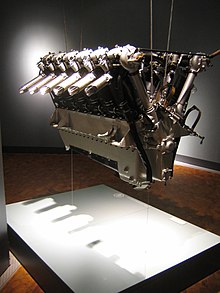
1926 BMW VI, water-cooled V12 aircraft engine
A V12 engine is a V engine with 12 cylinders mounted on the crankcase in two banks of six cylinders each, usually but not always at a 60° angle to each other, with all 12 pistons driving a common crankshaft.[1] Since each cylinder bank is essentially a straight-six which is by itself in both primary and secondary balance, a V12 inherits perfect primary and secondary balance no matter which V angle is used, and therefore it needs no balance shafts. A four-stroke 12 cylinder engine has an even firing order if cylinders fire every 60° of crankshaft rotation, so a V12 with cylinder banks at a multiples of 60° (60°, 120°, or 180°) will have even firing intervals without using split crankpins. By using split crankpins or ignoring minor vibrations, any V angle is possible. The 180° configuration is usually referred to as a "flat-twelve engine" or a "boxer" although it is in reality a 180° V since the pistons can and normally do use shared crankpins. It may also be written as "V-12", although this is less common.[2]
Contents
1 Applications
2 Early (pre WWI) V12 engines
2.1 Marine engines
2.2 Motor car engines
2.3 Early aero engines
3 Later V12s in aviation
4 V12 road cars
4.1 Postwar V12 production cars
4.2 Prototypes/custom made with V12 engines
5 Heavy trucks
6 Auto racing
7 Large diesel engines
8 Railway V12 diesel engines specs
9 Tanks and other AFVs
10 References
Applications
These engines deliver power pulses more often than engines with six or eight cylinders, and the power pulses have triple overlap (at any time three cylinders are on different stages of the same power stroke) which eliminates gaps between power pulses and allows for greater refinement and smoothness in a luxury car engine, at the expense of much greater cost, complexity and friction losses. In a racing car engine, the rotating parts of a V12 can be made much lighter than a V8 of similar displacement with a crossplane crankshaft because there is no need to use heavy counterweights on the crankshaft and less need for the inertial mass in a flywheel to smooth out the power delivery, and each piston can be smaller, lighter, and with a shorter stroke. Exhaust system tuning is also much more difficult on a crossplane V8 than a V12, so racing cars with V8 engines often use a complicated "bundle of snakes" exhaust system, or a flat-plane crankshaft which causes severe engine vibration and noise. This is not important in a race car if all-out performance is the only goal. Since cost and fuel economy are usually important even in luxury and racing cars, the V12 has been largely phased out in favor of engines with fewer cylinders.
Engines are often designed around cylinder units of a certain designed size, shape and speed. These are used as the working base of an engine, often of 6 cylinders. If more power is needed, it is easier to simply add more cylinders to increase displacement, without having to design a newer, larger cylinder and head for each engine size. Thus locomotive and marine engines like the EMD 567 come in V6 to V24 versions, all sharing the same 567 cubic inch cylinder displacement and cylinder heads.
Engines are also limited by the size of the cylinder bore and stroke. While one can increase the size of an engine by simply increasing the bore and/or stroke of the cylinder, a too-large bore hurts efficient combustion, and makes for a heavy reciprocating piston mass, which limits maximum engine speed and thus power output. In a similar vein, increasing the stroke means the piston speed must be increased to match the same revolutions per minute, and this also limits the maximum size of an engine in a given weight/size range. These factors make it more feasible to build an engine of 12 cylinders and 40 liters displacement than an engine of 6 cylinders and the same size, which would have pistons too large and a stroke too long to meet the same RPM and power requirements (although it would make more torque than the 12 cylinder).
In a large displacement, high-power engine, a 60° V12 fits into a longer and narrower space than a V8 and most other V configurations, which is a problem in modern cars, but less so in heavy trucks, and seldom a problem in large stationary engines. The V12 is common in locomotive and tank engines, where high power is required, but the width of the engine is constrained by tight railway clearances or street widths, while the length of the vehicle is more flexible. It is often used in marine engines where great power is required, and the hull width is limited, but a longer vessel allows faster hull speed.
In twin-propeller boats, two V12 engines can be narrow enough to sit side-by-side, while three V12 engines are sometimes used in high-speed three-propeller configurations. Large, fast cruise ships can have six or more V12 engines. In historic piston-engine fighter and bomber aircraft, the long, narrow V12 configuration used in high-performance aircraft made them more streamlined than other engines, particularly the short, wide radial engine.
During World War II the power of fighter engines was stepped up to extreme levels using multi-speed superchargers and ultra-high octane gasoline, so the extreme smoothness of the V12 prevented the powerful engines from tearing apart the light airframes of fighters. After World War II, the compact, more powerful, and vibration-free turboprop and turbojet engines replaced the V12 in aircraft applications.
Early (pre WWI) V12 engines
Marine engines
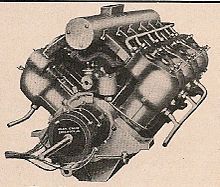
The 150 bhp V12 Dörwald marine motor, 1904
The first V-type engine (a two-cylinder V twin) was built in 1889 by Daimler, to a design by Wilhelm Maybach. By 1903 V8 engines were being produced for motor boat racing by the Société Antoinette to designs by Léon Levavasseur, building on experience gained with in-line four-cylinder engines. In 1904, the Putney Motor Works completed a new V12 marine racing engine—the first V12 engine produced for any purpose.[3] Known as the "Craig-Dörwald" engine after Putney's founding partners, the engine mounted pairs of L-head cylinders at a 90 degree included angle on an aluminium crankcase, using the same cylinder pairs that powered the company's standard two-cylinder car. A single camshaft mounted in the central V operated the valves directly. As in many marine engines, the camshaft could be slid longitudinally to engage a second set of cams, giving valve timing that reversed the engine's rotation to achieve astern propulsion. "Starting is by pumping a charge into each cylinder and switching on the trembler coils. A sliding camshaft gave direct reversing. The camshaft has fluted webs and main bearings in graduated thickness from the largest at the flywheel end."[4]Displacing 1,120 cu in (18.4 L) (bore and stroke of 4.875 in × 5 in (124 mm × 127 mm)), the engine weighed 950 pounds (430 kg) and developed 150 bhp (110 kW). Little is known of the engine's achievements in the 40-foot hull for which it was intended, while using the engine to power heavy freight vehicles was not realized.[3] One V12 Dörwald marine engine was found still running in a Hong Kong junk in the late-1960s.
Two more V12s appeared in the 1909-1910 motor boat racing season. The Lamb Boat & Engine Company of Clinton, Iowa built a 1,559 cu in (25.55 L) (5.25 in × 6 in (133 mm × 152 mm)) engine for the company's 32-foot Lamb IV. It weighed in at 2,114 pounds (959 kg). No weight is known for the massive 3,464 cu in (56.76 L) (7 in × 7.5 in (178 mm × 191 mm)) F-head engine built by the Orleans Motor Company. Output is quoted as "nearly 400 bhp [300 kW]".
By 1914, when Panhard built two 2,356 cu in (38.61 L) (5 in × 10 in (127 mm × 254 mm)) engines with four-valve cylinder heads the V12 was well established in motor boat racing.[3]
Motor car engines
In October 1913, Louis Coatalen, chief engineer of the Sunbeam Motor Car Company entered a V12 powered car in the Brooklands short and long handicap races. The engine displaced 9 L (550 cu in), with bore and stroke of 80 x 150 mm. An aluminum crankcase carried two blocks of three cylinders each along each side, with a 60 degree included angle. The cylinders were of iron, with integral cylinder heads with L-shaped combustion chambers. Inlet and exhaust valves were operated by a central camshaft in the V. Valve clearance was set by grinding the relevant parts, the engine lacking any easy means of adjustment. This pointed to Coatalen's ultimate aim of using the new V12 as an aero engine, where any adjustment method that could go wrong in flight was to be avoided. As initially built, the V12 was rated at 200 bhp (150 kW) at 2,400 rpm, weighing about 750 pounds (340 kg). The engine powered the car (named ‘Toodles V' for Coatalen's wife Olive's pet name) to several records in 1913 and 1914.[3]
Early aero engines
In 1909 Renault pioneered aero V12s with a 60 degree air-cooled engine with individual finned cylinders and F-head valve arrangement, driven by single camshaft in the crankcase. This was developed to a 12.2 L (740 cu in) unit (96 x 140 mm) which weighed 350 kg (770 lb) and produced 138 bhp (103 kW) at 1,800 rpm. The propeller was driven from the nose of the camshaft in the central vee, rather than from the crankshaft, thus providing an automatic half-speed reduction, improving propeller efficiency.[3]
Renault's designs were closely followed in Britain by the Royal Aircraft Factory. Its RAF 4 engine displaced 13.2 L (810 cu in) (100 x 140 mm), produced 140 bhp (100 kW) at 1,800 rpm, for a weight of 637 pounds (289 kg). Its RAF 4a derivative was produced in substantial numbers during the war.
By 1912 ABC Motors were offering a water-cooled engine of 17.4 L (1,060 cu in), claimed to produce 170 bhp (130 kW) at 1,400 rpm and weigh 390–520 pounds (180–240 kg) with radiator and coolant.
In March 1914 Sunbeam exhibited an airborne version of Toodles V's engine at Olympia. Racing in 1913 had helped to prove the design, and encouraged a 10 mm increase in bore to 90 mm, the stroke remaining at 150 mm. Its rated output was 225 bhp (168 kW) at 2,000 rpm. Named the ‘Mohawk', the engine was the most powerful available to British aviation at the outbreak of World War I. During the war further enlargement to 100 x 150 mm created the 240 bhp (180 kW) 'Gurkha'.[3]
Later V12s in aviation

A 1917 Liberty L-12 (V12) aero-engine
By the end of World War I, V12s were well established in aviation, powering some of the newest and largest fighters and bombers and being produced by companies such as Renault and Sunbeam. Many Zeppelins had 12-cylinder engines from German manufacturers Maybach and Daimler.
Austro Daimler of the Austro-Hungarian empire, produced also V12, designed by Ferdinand Porsche, with first 300 and later 345 hp, used with the big flying boats of the A-H Naval Air force.
Various U.S. companies produced the Liberty L-12. Soon after the end of World War I V12 engines powered the first trans-atlantic crossings by the Curtiss NC Flying boats (4 x Liberty L-12), the first non-stop crossing by Alcock and Brown in a Vickers Vimy (2× Rolls-Royce Eagles and the first airship crossing by HM airship R-34 (5× Sunbeam Maori).
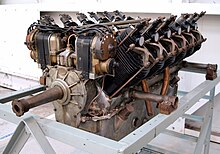
Renault V12 aeroengine
V12 engines reached their apogee during World War II. Fighters and bombers used V12 engines such as the British Rolls-Royce Merlin and Griffon, the Soviet Klimov VK-107 and Mikulin AM-38, the American Allison V-1710, or the German Daimler-Benz DB 600 series and Junkers Jumo. These engines generated about 1,000 hp (750 kW) at the beginning of the war and above 1,500 hp (1,100 kW) at their ultimate evolution stage. The German DB 605DC engine reached 2,000 hp (1,500 kW) with methanol/water injection called MW 50-equipment. In contrast to most Allied V12s, the engines built in Germany by Daimler-Benz, Junkers-Jumo, and Argus (As 410 and As 411) were primarily inverted, which had the advantages of lower centers of gravity and improved pilot visibility for single-engined designs. Only the pre-war origin BMW VI V12 of Germany was an "upright" engine. The United States had the experimental Continental IV-1430 inverted V12 engine under development, with a higher power-to-weight ratio than any of the initial versions of the German WW II inverted V12s, but was never developed to production status, with only 23 examples of the Continental inverted V12 ever being built. The only American-design inverted V12 engine of any type to see even limited service in World War II was the air-cooled Ranger V-770, which found use in stateside-based training aircraft like the Fairchild AT-21 Gunner twin-engined "advanced" trainer.
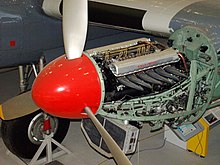
Rolls-Royce Merlin engine in an Avro York
The Rolls-Royce Merlin V12 powered the Hawker Hurricane and Supermarine Spitfire fighters that played a vital role in Britain's victory in the Battle of Britain. The long, narrow configuration of the V12 contributed to good aerodynamics, while its smoothness allowed its use with relatively light and fragile airframes. The Merlin was also used in the Avro Lancaster and de Havilland Mosquito bombers. In the United States the Packard Motor company was licensed by Rolls-Royce to produce the Merlin as the Packard V-1650 for use in the North American P-51 Mustang. It was also incorporated into some models of the Curtiss P-40, specifically the P-40F and P-40L. Packard Merlins powered Canadian-built Hurricane, Lancaster, and Mosquito aircraft, as well as the UK-built Spitfire Mark XVI, which was otherwise the same as the Mark IX with its British-built Merlin.
The Allison V-1710 was the only indigenous U.S.-developed V12 liquid-cooled engine to see service during World War II. A sturdy design, it lacked an advanced mechanical supercharger until 1943. Although versions with a turbosupercharger provided excellent performance at high altitude in the Lockheed P-38 Lightning, the turbosupercharger and its ductwork were too bulky to fit into typical single-engine fighters. While a good performer at low altitudes, without adequate supercharging, the Allison's high-altitude performance was lacking.
After World War II, V12 engines became generally obsolete in aircraft due to the introduction of turbojet and turboprop engines that had more power for their weight, and fewer complications.
V12 road cars
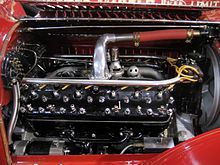
1916 Packard Twin-Six production V12
In automobiles, V12 engines have not been common due to their complexity and cost. They are used almost exclusively in expensive sports and luxury cars because of their power, smoother operation and distinctive sound.
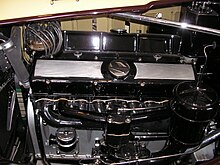
1931 Cadillac Series 370 A coupé V12
Prior to World War II, 12-cylinder engines were found in many luxury models, including cars from: Packard 1916 to 1923 and again from 1932 to 1939, Daimler 1926 to 1937, Hispano-Suiza 1931, Cadillac 1931, Auburn 1932, Franklin 1932, Lincoln 1932 to 1942 (continuing after the war through 1948), Rolls-Royce 1936, and Pierce-Arrow also 1936.
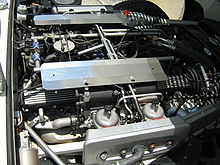
V12 engine in a Jaguar E-type
Vehicles with 8-, 12-, and 16-cylinders provide higher levels of refinement compared to those with fewer cylinders, especially important prior to the general adoption of vibration isolating engine mounts in the 1930s.
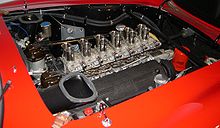
Ferrari 250 GTO V12
Packard's 1916 "Twin Six" is widely regarded as the first production V12 automobile engine. With a list price of US$1,000, the Auburn was the lowest priced V12 car ever (unadjusted for inflation). Production cost savings were achieved by using horizontal valves which, however, did not result in an efficient and powerful combustion chamber. Between 1916 and 1921,[5][page needed] there was a vogue of V12s, during which National (Indianapolis) copied the Packard engine,[citation needed] and Weidely Motors (also of Indianapolis) offered a proprietary engine. Soon after the end of World War I, Lancia offered a 22° V12, Fiat had a 60° model 520 (1921-2), British truck manufacturer Ensign announced a V12 that did not materialize, and in 1926, Daimler (Britain) offered the first of a full range of sleeve valve Double Sixes, 7,136 cc, 3,744 cc, 5,296 cc and 6,511 cc versions remaining available until 1937.[6][page needed] In 1927 more entered the market from Cadillac, Franklin, Hispano-Suiza, Horch, Lagonda, Maybach, Packard, Rolls, Tatra, Voisin, and Walter offering V12 engines. Cadillac (from 1930 to 1940) and Marmon (1931–33) even developed V16 engines.
Improvements in combustion chamber design and piston form enabled lighter V8 engines to surpass the V12 in power starting from the 1930s; only the smaller, H-Series Lincoln V-12 remained after World War II and it was replaced by a V8 in 1949. Similarly, as they seemed excessive for the postwar market in Europe, production of V12-engined-cars was very limited until the 1960s.
Ferrari has traditionally reserved their top V12 engine for their top-of-the line luxury sports coupes since 1949. Ferrari's closest rival, Lamborghini has also used the V12 configuration for many of its road cars since the company's inception in 1963.
In 1972, Jaguar introduced the XJ12, equipped with a 5.3 litre V12, which continued (after revisions in 1993) until the 1996 model year, after which the marque discontinued the twelve-cylinder engine.[7]
BMW returned to V12 designs for its 7 Series sedan in model year 1986, forcing Mercedes-Benz to follow suit in 1991. While BMW sells far fewer V12-engined 7 Series vehicles than V8 versions, the V12 is marketed in the U.S., China [1], and Russia.[8] The BMW-designed V12 is used in Rolls-Royce cars, while the Mercedes engine was installed in Maybach cars.
Mercedes S65 AMG, CL65 AMG, and SL65 AMG are powered by a V12 Bi Turbo engine making 463 kW (621 hp) and 1,000 N⋅m (740 lbf⋅ft) at 2,300-4,300 rpm. The CL65 AMG has a significant higher cost, but the V12 engine makes them a status symbol.[9]
The V12 engine is generally smoother than the other 12-cylinder configuration, the W12, although the W12 is more compact.[10][11]
In 1997, Toyota equipped their Century Limousine with a 5.0 L DOHC V12 (model # 1GZ-FE), making it the first and only Japanese production passenger car so equipped.
TVR made and tested a 7.7 L V12 called the Speed Twelve, but the project ended. The only British marques currently using a V12 configuration are Aston Martin — whose Cosworth-developed engine was authorized during the company's ownership by Ford Motor Company — and Rolls-Royce.
In 2009, China FAW Group equipped their Hongqi HQE with a 6.0 L DOHC V12 (model # CA12VG), making it the first and only Chinese production passenger car so equipped.
Most production V12 engines in road cars have an even firing order, with the uneven-firing exceptions such as Aston Martin 5.9L V12 and Mercedes-Benz M275 AMG V12s.
In 2008, Audi launched their Q7 model with a 5.9-litre V12 twin-turbo diesel engine, making it the first production passenger car so equipped. The engine also appeared in the R8 V12 TDI concept car.
Postwar V12 production cars
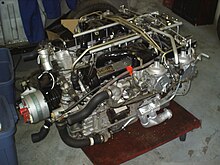
Jaguar V12 engine

Colombo Type 125 'Testa Rossa' engine in a 1961 Ferrari 250TR Spyder
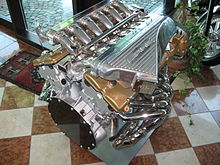
Mercedes-AMG V12 engine, on display at the Pagani Factory in Italy
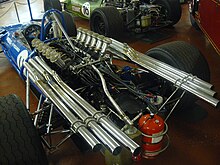
Matra MS11 from 1968
This is a list of V12-engined production road cars produced since 1945, sorted alphabetically by make (and sub-sorted by year of introduction):
- Aston Martin DB7 Vantage
- Aston Martin Vanquish
- Aston Martin DB AR1
- Aston Martin DB9
- Aston Martin DBS (2008–12)
- Aston Martin V12 Vantage / V12 Vantage S
- Aston Martin One-77
- Aston Martin Rapide
- Aston Martin Virage (2011–12)
- Aston Martin V12 Zagato
- Aston Martin DB11
- Aston Martin Valkyrie
- Audi Q7 V12 TDI
- B Engineering Edonis
- BMW 750i / 750iL (E32 & E38) / 760i / 760Li (E65 & F01)
- BMW 850i / Ci / CSi
- Bugatti EB110
- Bugatti EB112
- Daimler Double Six
- Ferrari 125
- Ferrari 166
- Ferrari 195
- Ferrari 212
- Ferrari 340 / 342 / 375 / 375 America
- Ferrari 250
- Ferrari 250 GT Lusso
- Ferrari 410 / 400 Superamerica
- Ferrari 275
- Ferrari 330
- Ferrari 500 Superfast
- Ferrari 365 California
- Ferrari 365 GT 2+2
Ferrari 365 GTC & GTS- Ferrari 365 GTB/4 & 365 GTS/4 "Daytona"
- Ferrari 365 GTC/4
- Ferrari 365 GT4 2+2
- Ferrari 400 / 400i / 412
- Ferrari 456 / 456M
- Ferrari F50
- Ferrari 550 Maranello / Barchetta Pininfarina
- Ferrari 575M Maranello / 575M Superamerica
- Ferrari Enzo
- Ferrari 612 Scaglietti
- Ferrari 599 GTB Fiorano / 599 GTO
- Ferrari FF
- Ferrari F12berlinetta / F12tdf
- Ferrari LaFerrari
- Ferrari GTC4Lusso
- Ferrari 812 Superfast
- Hongqi HQE/L7/L9
- Hongqi L5
- Jaguar E-Type V12
- Jaguar XJ-S
- Jaguar XJ12 & XJ12C
- Jaguar XJR15
- Lagonda Taraf
- Lamborghini 350GT
- Lamborghini 400GT
- Lamborghini Islero
- Lamborghini Miura
- Lamborghini Espada
- Lamborghini Jarama
- Lamborghini Countach
- Lamborghini LM002
- Lamborghini Diablo
- Lamborghini Murciélago
- Lamborghini Reventón
- Lamborghini Aventador
- Lamborghini Veneno
- Lamborghini Centenario
- Lincoln Continental
- Lincoln H-Series
- Lister Storm
- Lotec Sirius
- Maserati MC12
- Maybach 57 and 62
- McLaren F1
- Mercedes-Benz CL600 / CL65 AMG
Mercedes-Benz S600 / S65 AMG- Mercedes-Benz SL600 / SL65 AMG / SL70 AMG / SL73 AMG
- Mercedes-Benz CLK GTR AMG
Mercedes-Benz G65 AMG / Mercedes-AMG G65 / Mercedes-Maybach G650 Landaulet- Pagani Zonda
- Pagani Huayra
- Panther De Ville
- Panther J72
- Rolls-Royce Silver Seraph / Silver Seraph Park Ward
- Rolls-Royce Phantom (2003–)
- Rolls-Royce Phantom Drophead Coupé (2007–17)
- Rolls-Royce Phantom Coupé (2008–17)
- Rolls-Royce Cullinan
- Rolls-Royce Ghost
- Rolls-Royce Wraith (2013–)
- Rolls-Royce Dawn
- Toyota Century (1996–2015)
- Tramontana R
- Vector M12
Some tuner companies, such as Brabus, also sell V12 versions of the Mercedes-Benz E-Class and CLS, which were the fastest street-legal sedans upon their respective introductions.
Prototypes/custom made with V12 engines
- Apollo Intensa Emozione
Aston Martin Vulcan (not road-legal)- Audi R8 Le Mans Concept
BAIC C90L
BMW Nazca M12 (a concept by Italdesign)- BMW CS Concept
- BMW M8 Prototype
- Bertone Genesis
- Cadillac Cien
- Chrysler ME Four-Twelve
- Ferrari F12 TRS
Ferrari FXX (not road-legal)
Ferrari FXX-K (not road-legal)- Ferrari P540 Superfast Aperta
- Ford GT90
- Ford Indigo
Isdera Commendatore 112i- Jaguar XJ13
- Jaguar XJ220 Concept
- Lamborghini Flying Star II
- Lamborghini LM004
- Laraki Fulgura
Lincoln Continental (2002 concept)- Maybach Exelero
- Méga Monte Carlo
Peugeot 907 (Peugeot's first V12, 2004)- Rolls-Royce Sweptail
- Toyota Century Royal
TVR Cerbera Speed Twelve (never entered production)- Volga V12 Coupe (a one-off custom rebody)
- Yamaha OX99-11
- Zagato Raptor
Heavy trucks

1961 GMC Gasoline V12 702 cu in (11.50 L)
Tatra used a 17.6 L (1,070 cu in) air-cooled naturally aspirated V12 diesel engine in many of their trucks; for instance, the Tatra T813 and uses 19 L air-cooled naturally aspirated or turbo V12 diesel engine in Tatra T815. Some large trucks have been fitted with twin V12s that drive a common shaft, although this is often advertised as a V24.
GMC produced a large gasoline-burning V12 from 1960 to 1965 for trucks, the "Twin-Six"; it was basically GMC's large-capacity truck 351 V6, doubled, with four rocker covers and four exhaust manifolds.[12] Fifty-six major parts are interchangeable between the Twin-Six and all other GMC V6 engines to provide greater parts availability and standardization. Its engine displacement was 702 cu in (11.50 L), and while power was not too impressive at 250 hp (190 kW), torque was 585 lb⋅ft (793 N⋅m). For firetrucks the rev limiter was increased to produce 299 hp (223 kW) at 3000 rpm and torque was increased to 630 lb⋅ft (850 N⋅m) at 1600–1900 rpm. It was possibly the last gasoline engine used in heavy trucks in the US.
Fire apparatus manufacturer Seagrave used two versions of the Pierce Arrow V-12 motor starting in 1935. After Pierce-Arrow ended production in 1938, Seagrave bought the machine tools and continued to build and offer these engines until 1970. American La France, beginning in 1931, also offered apparatus with a series of V-12 motors built by ALF but developed from the Lycoming BB motor. Both manufacturers stopped offering a V-12 option when fire departments began specifying diesel engines in their orders.
Detroit Diesel produced their Series 53, 71, 92, and 149 engines as V-12s, among other configurations.
Auto racing
V12 engines used to be common in Formula One and endurance racing. From 1964 to 1980, Ferrari, Weslake, Honda, BRM, Maserati, Matra, Delahaye, Peugeot, Delage, Alfa Romeo, Lamborghini, and Tecno used 12-cylinder engines in Formula One, either V12 or flat-12. The last V12 engine used in Formula One was the Ferrari 044, on the Ferrari 412T2 cars driven by Jean Alesi and Gerhard Berger in 1995.

Lamborghini's 3512 V12 Formula One engine, at the Lamborghini Museum
In the late 1960s Nissan used a V12 in the Japanese Grand Prix and again in the early-1990s Group C races.

1991 Honda RA121E engine
At the Paris motor show 2006 Peugeot presented a new racing car, as well as a luxury saloon concept car, both called 908 HDi FAP and 908 RC and fitted with a V12 Diesel engine producing around or even surpassing 700 PS (515 kW; 690 hp). This took part in the 24 Hours of Le Mans 2007 race, coming in second place after the similarly conceived Audi R10 TDI V12 Diesel originally developed for the 2006 season.
Large diesel engines
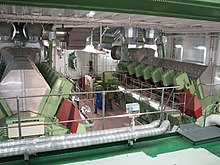
Two large V12 marine diesel engines
V12 is a common configuration for large diesel engines; most are available with differing numbers of cylinders in V configuration to offer a range of power ratings. Many diesel locomotives have V12 engines. Examples include the 3,200 hp (2.39 MW) 12-710 from Electro-Motive Diesel and the 4,400 hp (3.28 MW) GEVO-12 from GE Transportation.
Large V12 engines are also common in ships. For example, Wärtsilä offers V12 engines with various cylinder bore diameters between 26 and 50 centimetres (10 and 20 in) with power output ranging from 4,080 to 14,400 kW (5,470 to 19,310 hp). These engines are commonly used especially in cruise ships, which may have up to six such main engines.[13] The largest medium-speed diesel engine, Wärtsilä 64, was also offered in V configuration, and a single 12V64 prototype with an output of 23,280 kW (31,220 hp) was produced for an experimental power plant in the late 1990s.[14]
Railway V12 diesel engines specs
Railway Diesel engines with 12 cylinder developing 500 kW (680 PS; 671 hp) and more:
| Manufacturer | Type | Bore | Stroke | Engine displacement | rpm | KW | kg |
|---|---|---|---|---|---|---|---|
| MTU | R43 | 170 mm (6.7 in) | 195 mm (7.7 in) | 53,113 cc (53.113 L) | 1800 | 2400 | 6000 |
| MTU | 2000 | 130 mm (5.1 in) | 150 mm (5.9 in) | 23,892 cc (23.892 L) | 1800 | 600 | 3000 |
| EMD | 710 | 190 mm (7.5 in) | 210 mm (8.3 in) | 71,449 cc (71.449 L) | 950 | 2500 | |
| GE | 7FDL | 220 mm (8.7 in) | 230 mm (9.1 in) | 104,917 cc (104.917 L) | 1050 | 2400 | |
| Cummins | Qs | 170 mm (6.7 in) | 190 mm (7.5 in) | 51,751 cc (51.751 L) | 1800 | 2200 | |
| MAN | 2842 | 128 mm (5.0 in) | 145 mm (5.7 in) | 22,390 cc (22.39 L) | 2800 | 580 | |
| CAT | 3512 | 150 mm (5.9 in) | 170 mm (6.7 in) | 36,050 cc (36.05 L) | 1800 | 1500 | |
| Perkins | |||||||
| Wartsila | 200 |
Tanks and other AFVs

Chrysler V12 tank engine
The V12 is a common configuration for tank and other armoured fighting vehicles (AFVs). Some examples are:
- German Maybach HL120TRM gasoline engine, used on World War II Pz Kpfw III and Pz Kpfw IV tanks.
- British Rolls-Royce Meteor gasoline engine, derived from the Merlin aero-engine, used on World War II Cromwell and Comet tanks and the post-World War II Centurion and Conqueror tanks.
- Russian V-2 (В-2) V-12 diesel engine, used on World War II T-34, KV-1, KV-2 and IS-2 tanks. Most modern Russian diesel engines for MBTs goes back to V-2 base design.
- American Continental AV1790 engine, produced in gasoline and diesel variants, used on all versions of the Patton tank and on the M103 heavy tank. One of these engines was used to power a hot rod style car called the Blastolene Special.
- The 26.6 litre Perkins diesel engine in the Challenger 2 main battle tank and its variants.
References
| Wikimedia Commons has media related to V12 engines. |
^ Nunney, Malcolm James (2007). Light and Heavy Vehicle Technology (Fourth ed.). Butterworth-Heinemann. pp. 13–14. ISBN 978-0-7506-8037-0..mw-parser-output cite.citationfont-style:inherit.mw-parser-output .citation qquotes:"""""""'""'".mw-parser-output .citation .cs1-lock-free abackground:url("//upload.wikimedia.org/wikipedia/commons/thumb/6/65/Lock-green.svg/9px-Lock-green.svg.png")no-repeat;background-position:right .1em center.mw-parser-output .citation .cs1-lock-limited a,.mw-parser-output .citation .cs1-lock-registration abackground:url("//upload.wikimedia.org/wikipedia/commons/thumb/d/d6/Lock-gray-alt-2.svg/9px-Lock-gray-alt-2.svg.png")no-repeat;background-position:right .1em center.mw-parser-output .citation .cs1-lock-subscription abackground:url("//upload.wikimedia.org/wikipedia/commons/thumb/a/aa/Lock-red-alt-2.svg/9px-Lock-red-alt-2.svg.png")no-repeat;background-position:right .1em center.mw-parser-output .cs1-subscription,.mw-parser-output .cs1-registrationcolor:#555.mw-parser-output .cs1-subscription span,.mw-parser-output .cs1-registration spanborder-bottom:1px dotted;cursor:help.mw-parser-output .cs1-ws-icon abackground:url("//upload.wikimedia.org/wikipedia/commons/thumb/4/4c/Wikisource-logo.svg/12px-Wikisource-logo.svg.png")no-repeat;background-position:right .1em center.mw-parser-output code.cs1-codecolor:inherit;background:inherit;border:inherit;padding:inherit.mw-parser-output .cs1-hidden-errordisplay:none;font-size:100%.mw-parser-output .cs1-visible-errorfont-size:100%.mw-parser-output .cs1-maintdisplay:none;color:#33aa33;margin-left:0.3em.mw-parser-output .cs1-subscription,.mw-parser-output .cs1-registration,.mw-parser-output .cs1-formatfont-size:95%.mw-parser-output .cs1-kern-left,.mw-parser-output .cs1-kern-wl-leftpadding-left:0.2em.mw-parser-output .cs1-kern-right,.mw-parser-output .cs1-kern-wl-rightpadding-right:0.2em
^ "Rolls-Royce Condor IA, V-12 Engine". National Air and Space Museum. 2016-03-10. Retrieved 2017-05-24.
^ abcdef Ludvigsen, Karl (2005). The V12 Engine. Sparkford, Yeovil: Haynes. pp. 14–19. ISBN 978-1-84425-004-2.
^ M. Dörwald, The Automobile Commercial Vehicle Review, August 1904).
^ Georgano, G.N. (2002). Cars: Early and Vintage, 1886–1930. Mason Crest. ISBN 978-1-59084-491-5.
^ Georgano 2002.
^ "Technical history of the Jaguar V12". Jag Web. Retrieved 29 January 2015.
^ "2010 BMW 760i/760Li". Car & Driver (first drive auto review). July 2009. Retrieved 2011-09-29.
^ "2013 Mercedes-Benz CL65 AMG review notes". Autoweek. August 25, 2013. Retrieved 29 January 2015.
^ "2013 BMW 760Li review notes". Autoweek. July 21, 2013. Retrieved 7 February 2015.
^ "2005 Audi A8 Review and Photos". New Car Test Drive. Retrieved 7 February 2015.
^ Mort, Norm (2010). American Trucks of the 1960s. Veloce. pp. 41–44. ISBN 978-1-84584-228-4. Retrieved 6 October 2010.
^ "Medium-speed engines". Wärtsilä. Retrieved 29 January 2015.
^ "Diesels offer hot Competition". Power Engineering International. 1 September 1998. Retrieved 29 January 2015.

